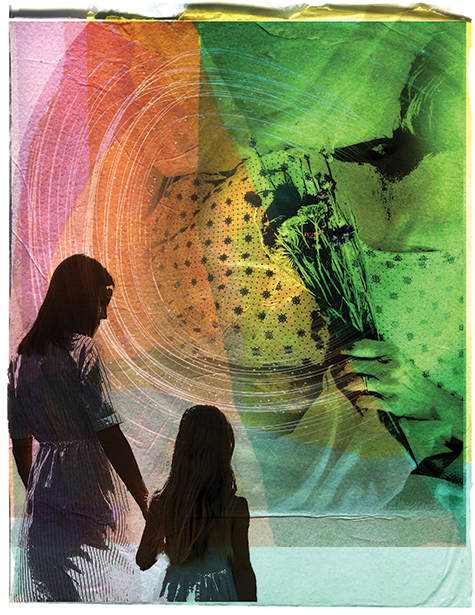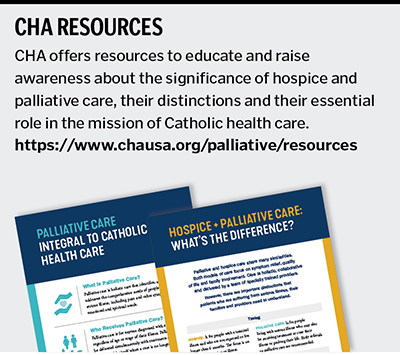
Chaka Brittain's mother used to bring her along on her visits to terminally ill people in her community. "My mom was somewhat of a death doula, if you would," she said. "I remember even as a young girl going to people's houses, and they were dying. She'd come in and sit with them and stay with them until they had 'gone to glory.'"
Now a palliative nurse practitioner and assistant professor of nursing at the University of North Florida, Brittain believes these early experiences prepared her to work with seriously ill or dying patients. "Death was never scary. My mother never really explained it, but she never shielded me from it," she said.
"I wish that we had more honest, transparent conversations as a nation around the end of life and what it really looks like." — Ashley Neville
Brittain's ease around death is not the norm in America, where human mortality remains a taboo topic. Americans would prefer to discuss any other third-rail subject over dying, including money, politics or religion, according to one survey by Ethos, a life insurance company.1
This reticence can make navigating a serious illness even more challenging, contributing to family conflict, reluctance to seek resources such as hospice or palliative care, and hampering communication.
"One of the biggest challenges with serious illness is the impact that it has on people's relationships with everyone around them," said Sheri Bartlett Browne, spiritual care manager at Ascension Saint Thomas in Nashville. "And the other is the fear of the unknown."
For health care providers, chaplains, hospice and palliative care specialists, helping families in these circumstances requires tools to break down cultural and interpersonal barriers. But some also say a broader shift is needed.
"I wish that we had more honest, transparent conversations as a nation around the end of life and what it really looks like," said Ashley Neville, a supervisor of holistic care at PeaceHealth Whatcom Hospice in Bellingham, Washington.
A PROGNOSIS OF SILENCE
Sick patients sometimes don't know they're dying, because their doctor can't get the words out, Brittain said. For some doctors, the idea that the patient has exhausted treatment options and is moving toward end-of-life care sometimes feels like a personal failure. "I've had providers tell me that they can't do it because the patient will feel like they're giving up on them," she said.
It's not only doctors that have difficulty conveying the truth. Patients sometimes try to shield family members from a harsh reality and vice versa. "People always try to protect the people that they love, understandably. But the less that everybody can be silenced in that, the better," Browne said. Hiding the patient's prognosis doesn't spare anyone from its course and can make it harder to manage.
"Chaplains, in their role, are often the bridge builders. We're focused on the relationships, building rapport with family, with a patient, and trying to listen for opportunities to bring people together." — Sheri Bartlett Browne
When asked, patients appear to prefer the truth. A recent AARP survey found that 88% of those polled said their doctor should provide a realistic, not a hopeful, view of their condition.2 They also want to have the ability to plan. Some 92% of Americans say it's important to discuss their wishes for end-of-life care, and 95% are willing, however, only 32% have had the conversation, according to the Institute for Healthcare Improvement's Conversation Project.3
People working with patients and families are often left to fill the gaps.
"By not telling the truth, you silence conflicts that are already there in the family system," Browne said. "And if you can start to tell the truth about this and face it together, then perhaps there's other things that you will be able to face."
NAVIGATING FAMILY DYNAMICS
Communication is also a challenge when navigating care decisions for a patient. "You can end up with many family and friends with a lot of opinions about what this person should do. And that creates a lot of stress and a lot of conflict," Browne said.
The most difficult situations arise when the patient's wishes aren't clear, and they aren't able to speak for themselves. "I had a patient with an anoxic brain injury. She had 10 children, the youngest was 19, and she never named a surrogate," Brittain said. In this case, the family dynamics made it virtually impossible to gain a needed consensus.
Conflicts often center on how far to go with medical interventions. "A common issue is, for example, someone saying, 'I want my mom to do everything. I want her to live forever. I want her to go through every possible treatment,'" Browne said. Mom might disagree but feel guilty if she opts to forgo taxing treatments that aren't likely to extend her life. People's views on treatment may be driven by their relationship with the patient, cultural factors or religious views. The question becomes whose voice will prevail and whether the chosen path aligns with the patient's wishes.
"Chaplains, in their role, are often the bridge builders. We're focused on the relationships, building rapport with family, with a patient, and trying to listen for opportunities to bring people together," Browne said. "As you mirror back what people are reflecting or how they are processing what is going on, you can look for opportunities to be a mediator, to de-escalate conflict, and to let everybody feel that they are heard."
Many patients and families facing end-of-life care are waiting and hoping for a miracle, Brittain said. Patients and families often don't realize what medical interventions involve or the toll they take on patients. "I think this is where it gets really tricky because, as providers, we want to respect faith and that belief in miracles, but there's also that desire for us to get them to understand the medical piece," she said.
A 2024 study looked at how public health is portrayed on television versus in reality by looking at two popular shows, House and Grey's Anatomy.4 They found that these shows often misrepresented specific interventions, such as cardiopulmonary resuscitation. "CPR is not what you see on TV," Brittain said. "When we do it, we break ribs, we puncture lungs and we bust sternums." And CPR is successful only 21% of the time when carried out in a hospital by trained professionals, according to the American Red Cross.5
Explaining the realities of treatments and interventions can help families make more informed decisions. "At the end of the day, if they say that they still want all the interventions, at least I know that they know exactly what they're signing up for," Brittain said.
Some people will still opt to exhaust every option. Brittain said cultural factors may play a role. Many of her Black families are unwilling to stop medical treatments, holding out for a miracle. Some evidence supports Brittain's anecdotal experience. A survey in 2016 found that Black and Hispanic Americans were more likely to prioritize living as long as possible.6
For example, while living as long as possible ranks below other considerations across racial and ethnic groups, Blacks (45%) and Hispanics (28%) are more likely than whites (18%) to say this is "extremely important" to them, according to one poll. Blacks and Hispanics were more likely than whites to say the health care system in the U.S. places too little emphasis on extending life as long as possible, according to KFF, a health policy organization.7
For Black Americans, who have historically endured suffering and oppression, views about persisting through adversity may drive these decisions, Brittain said. "It's almost like that same mentality still is ingrained in the culture of Black Americans. Suffering is not a bad thing. It's what you have to endure. Life is hard, you suffer, but you have faith, and things will turn around," she said.
Decisions like these may also be fueled by distrust of the medical system. Brittain, who is Black, said many families are often relieved to see her walk in, a face that looks like their own, which engenders trust. "I think there is a need for some reassurance that, yes, all these physicians have told me that I am going to die, but I need to be sure that they're just not trying to avoid treating me," she said.
Family decisions to persist with likely ineffective treatments can be difficult for health care providers who have already seen the path ahead for many patients. To help understand why patients take this challenging road, Brittain explored religious views and theories, such as vitalism, which views life as more than biology and often prompts people to try and maintain it at all costs.
"I don't think a lot of my colleagues really know how to approach it, because we see a lot of suffering, and we naturally are empaths. We don't want people to suffer. But this person, this family, doesn't see it as suffering like we do," Brittain said. In the end, allowing families to experience the process in their own way can build trust, she said.
MEASURES TO HELP FAMILIES
Whatever path the patient chooses, there are other measures that health care professionals can take to make the process easier.
A crucial step is helping patients assign decision-makers and to communicate their wishes. This includes choosing a health care proxy or proxies who can make decisions based on the patient's wishes. Planning should also include other aspects of end-of-life care as well. "We never have enough people who have done their own end-of-life care planning. Many have not signed an advance directive, or don't have a living will, and often that makes things very complicated," Ascension's Browne said.
While many people say they worry about how their illness and death will affect loved ones and pets, they rarely act. "While over six in 10 (63%) older adults say they have had an end-of-life conversation with a loved one, far fewer have made end-of-life preparations, like preparing a last will and testament (36%) or a living will (33%). Moreover, less than half of the adults ages 45 and older who have not made these or similar preparations, say it is very likely they will," according to an AARP study.8
Health care providers can also encourage families to seek resources, such as palliative or hospice care for a seriously ill family member. Palliative care provides support for people with a serious but not imminently terminal illness, and can include curative treatments. For people in the early stages of a serious illness, it can help with symptom management, give them a better understanding of their medical condition and its progression, document their preferences for end-of-life care, and reduce the amount of time they'll need to spend in the hospital.9 Hospice care offers needed support to families who are often struggling to meet the needs of a family member who is likely to die within six months, said Dr. Shelley Rice, medical director at PeaceHealth Whatcom Hospice. Most people don't reach out for services until too late in the process.
"Anybody who's experiencing a serious illness is scared. They're not sure. They receive a lot of information from their medical team. They get information and advice from people all around them. And there's just so much uncertainty." — Sheri Bartlett Browne
"I would encourage families to think about hospice much earlier and not to think of it as throwing in the towel, but to think of it as gaining resources," she said. People are sometimes reluctant to make this shift due to fears that going onto hospice will shorten their life, she said, which isn't true. The goal of hospice is to help people live as well as possible with good symptom management for the time that they're granted.
Planning can also help people carry out their end-of-life wishes, when feasible.
"As other research has shown, most Americans (71%) say that given the choice, they would prefer to die at home, with few saying they would choose a hospital (9%), hospice (7%) or nursing home (1%)," according to KFF.10
"That planning ahead part is a lot of what our team does for folks, which is helping to have those conversations. And they're hard, because I think a lot of people really do think that 'Oh, my insurance is going to cover that cost to be in a skilled nursing facility,' and it usually doesn't," PeaceHealth's Neville said.

Beyond planning and logistics, what patients need is support, both emotional and spiritual. "Anybody who's experiencing a serious illness is scared," Browne said. "They're not sure. They receive a lot of information from their medical team. They get information and advice from people all around them. And there's just so much uncertainty." They often need to tell their story over and over again, she said. "Listening is active, you're responding. An important aspect would be to ask open-ended questions. Instead of saying, 'Oh, that must be really hard for you,' it's better to say, 'Wow, you know, that sounds kind of scary,' or, 'That sounds frustrating. Could you tell me more about that?'" Browne said.
OFFERING CLOSURE AND MEANING
It's also important to meet patients where they are. "Sometimes the difficulty is that what we, as caregivers, define as a good death doesn't necessarily match up with what our patients feel," Rice said. The same is true of family expectations. The goal is to remain focused on giving the patient what they need.
Having that support can help patients and families explore aspects of the life transition that are truly important. "It can open everything up, to provide space to have those hard conversations, important conversations, and for all of the folks involved in that family to think about what really is meaningful," Neville said. This offers the closure and connection people crave at the end of life.
PeaceHealth has helped patients not only bridge gaps with family members, but realize dreams, such as returning to their alma mater on a virtual reality trip, or real-life stadium seats to see the Seattle Seahawks play. "Those things, I think, fill everybody's cup, the days when you really can make a dream come true. That may not be the day-to-day work, but gosh, they're really kind of sparkly moments for everybody," Rice said.
Death can be a mirror for life. "I think when we feel like we've had a full and meaningful life, it's easier to be prepared for a peaceful and natural death," Rice said. "I think so many of these conversations are about how we want to live, as well as knowing that death is coming."
Working with families living through these moments is hard. "But it's also so beautiful and vulnerable and raw, and that's why I love this work, because it's just humanity in its most real form," Neville said.
KELLY BILODEAU is a freelance writer who specializes in health care and the pharmaceutical industry. She is the former executive editor of Harvard Women's Health Watch. Her work has also appeared in The Washington Post, Boston magazine and numerous health care publications.
NOTES
- "With End-of-Life Preparedness, Actions Speak Louder than Words, Ethos Survey Finds," PR Newswire, July 13, 2022, https://www.prnewswire.com/news-releases/with-end-of-life-preparedness-actions-speak-louder-than-words-ethos-survey-finds-301585801.html.
- "Views on End of Life," AARP, 2024, https://www.aarp.org/content/dam/aarp/research/topics/aging-experience/demographics/end-of-life-views.doi.10.26419-2fres.00782.002.pdf.
- "About Us," The Conversation Project, https://theconversationproject.org/about/.
- Daniela Zago et al., "TV Medical Dramas: Assessing the Portrayal of Public Health in Primetime," Frontiers in Public Health 12 (July 24, 2024): https://doi.org/10.3389/fpubh.2024.1432528.
- "CPR Facts and Statistics," American Red Cross, October 2, 2024, https://www.redcross.org/take-a-class/resources/articles/cpr-facts-and-statistics.
- Liz Hamel, Bryan Wu, and Mollyann Brodie, "Views and Experiences with End-of-Life Medical Care in the U.S.," KFF, April 27, 2017, https://www.kff.org/report-section/views-and-experiences-with-end-of-life-medical-care-in-the-us-findings/.
- Hamel, Wu, and Brodie, "Views and Experiences with End-of-Life Medical Care in the U.S."
- Cheryl L. Lampkin, "Thoughts on End of Life: For Most, Concerns Do Not Equate to Action," AARP, March 18, 2024, https://www.aarp.org/pri/topics/aging-experience/demographics/death-dying-end-of-life/.
- A related study on early palliative care for cancer patients: Dan Monnery and Joanne Droney, "Early Palliative Care and Its Impact on End of Life Care," Current Opinion in Supportive and Palliative Care 18, no. 4 (December 2024): https://doi.org/10.1097/SPC.0000000000000729.
- Hamel, Wu, and Brodie, "Views and Experiences with End-of-Life Medical Care in the U.S."
QUESTIONS FOR DISCUSSIONNavigating a serious or life-threatening illness is challenging for patients and their family members, friends and care providers.
|
